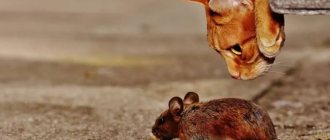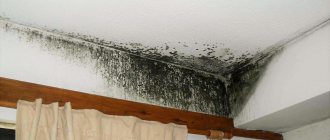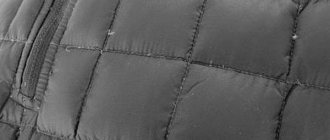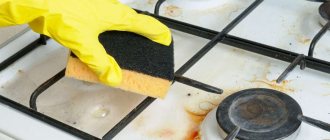You can get rid of mice using a mousetrap, sticky trap, homemade device, ultrasonic repellents or chemicals. Each method has been tested by time and user reviews and is distinguished by certain features. Let's look at the most popular and effective methods of rodent control using specific examples.
How to get rid of rodents in the house Source parazit.guru
Physical methods
There are many types of mousetraps, traps and traps for mice. The difference lies in the mechanism of action and the principle of catching rodents. Compact devices are easily installed in mouse habitats, where they often pass in search of food. The most popular types of physical mouse traps are those presented below.
Classic mousetraps
The advantage of classic mousetraps is the possibility of repeated use immediately after the caught animal is removed. To do this, install a new bait and cock the return spring. You don’t have to do anything else; replacement of parts and consumables is not provided here.
Trap
This refers to a metal cage with a raised door. The bait lies in the far corner and presses the thread that holds the locking mechanism. The principle of operation of the device is that the animal enters the cage, heading towards the bait, releases the thread, thereby closing the door, the mouse remains inside.
Another type of mouse trap is a small box with an entrance that only works in one direction. Having caught the aroma of bait, the rodent gets inside, but is no longer able to get out.
Electrical accessories
An electric mouse trap can be powered by AA batteries or from an outlet. The device is built on the principle of placing bait inside an energized zone. The mouse sees a tasty morsel and moves towards it, stepping on the wires and receiving an electric shock, the value of which is sufficient to cause its death.
Electric traps are quite popular and differ in size and the presence of additional options, for example, it can be a chamber for storing corpses, sound or light indicators of capture.
Important! The devices operate on electricity. When the batteries are disconnected or low, they turn off.
Glue trap
An equally effective way to control rodents. Presented in the form of a regular plate treated with a sticky non-toxic composition. The mice become glued to the base, unable to free themselves.
Important! When using such devices, you need to be prepared to peel the caught mouse off the base while it is still alive. As an alternative, many people throw away the stickers along with the caught animal.
What danger do they pose?
A mouse infestation in itself is a nuisance. These are small, dirty, unpleasant creatures that brazenly invade pantries and nightstands for food. Rodents cause harm not only to food, furniture and the integrity of walls, they pose a danger to human health:
- In some people, products used by mice cause an allergic reaction.
- Close proximity to pests carries the risk of infection with infectious diseases. Mice are carriers of bacteria and germs.
- Gray rodents damage wiring and cable communications, resulting in a short circuit in the network.
- Causative agents of dangerous infections live in the saliva and droppings of pests. With the appearance of mice, fleas enter the room, living in the short fur of basement rodents.
- Mice spoil food products: they “drill” holes in bags of flour and cereals, eat through packages of pasta, grind seeds, crackers, and bread. Rodents do not disdain vegetables, leaving teeth marks on potatoes, carrots, and cabbage.
After death, the corpses of mice must be removed as quickly as possible, since the cadaverous smell of rodents is toxic to people and can cause severe headaches or poisoning.
When uninvited guests enter residential premises, they damage furniture, books and other products. They make nests in the far corners of pantries, dragging small wardrobe items. Rodents damage shoes, clothes, wallpaper and, among other things, spread a disgusting smell.
Homemade traps
Do-it-yourself mousetraps are simple, uncomplicated devices that are no different in effectiveness from store-bought ones. And some may even surpass them in terms of the number of “catch”.
Important! When designing a homemade trap using a container (cans, bottles), use sunflower oil. By pouring it inside, you will make the animal’s paws become oily, which will not allow it to escape, moving along the inner walls of the vessel.
One and a half trap
Only a bottle with a standard narrow neck is suitable for this. The 5-liter is not suitable due to the wide neck. The procedure is as follows:
- Tie a strong thread or rope to the neck.
- The other end is to the top of the table leg.
- Place bait inside.
- Place the bottle horizontally, so that at least 2/3 of the bottle hangs from the table.
Trap in action Source cdn.fishki.net
The meaning of the trap is that the mouse, having penetrated the bottle, will run to the bait. Once in the back (hanging part), the container will tilt, it will tilt and fly down. The cord will not allow the bottle to fall - this way the trap will be suspended in the air, and the rodent will not be able to get out due to the narrow hole.
Trap from a jar, bucket
The principle is that the upper part of the container is sealed with paper, in which an incision is made crosswise. The bait is placed inside. To increase the effectiveness of the method, build a bridge for the mouse, making it easier for it to get up to the paper false cover. In this case, it is enough to lean against an ordinary ruler or a branch brought from the garden.
Trap with false lid Source i5.otzovik.com
The point of the trap is that, sensing the smell of bait in the bucket, the mouse falls on the paper lid and falls through the cuts made. She won't be able to get out because her paws are stained with oil.
Salt trap
Pour water into a bucket and make a strong salty brine in it. You can hide the liquid by adding sawdust. Their quantity should be such as to completely cover the surface after swelling. Place fragrant bait in the central part. Next, you can organize a bridge from a wooden ruler, or you can leave it without it. The principle of operation of the trap is that a rodent, driven by the desire to eat the bait, steps onto sawdust or a bridge and falls into the salt concentrate. He will no longer be able to get out of it.
Glue trap
In this case, you will need special mouse glue. The consistency is spread on cardboard or something else, and the bait is placed in the center. A mouse caught in glue cannot free itself and dies from dehydration.
Glue trap for rodents Source i5.otzovik.com
Important! The disadvantage of this method is that the trap is considered disposable. It has to be thrown away along with the dead mouse.
Wooden house
Assembling a wooden house is one of the most labor-intensive ways to catch mice using improvised means. The principle of the device is that a box is assembled that looks like a birdhouse, but with entrances not in the front, but on the sides.
It should consist of two parts: the bait is suspended in the upper one, and the lower one is used as a place for imprisoning mice. To prevent escape as a result of a chewed board, line the inner walls of this area with tin. Between the top and bottom, a bridge is made of two planks with springs holding them in a horizontal position. Under the weight of the rodent, they bend - the animal falls into the lower part. The released board-bridge rises to its original position and is ready to receive the next visitor.
Why are mice dangerous?
Rodents spoil food supplies - they eat and stain cereals, flour and sugar with their feces. They make nests in sofas and upholstered furniture, chew through wiring and plastic pipes, and chew holes in walls and decorative panels. The design of their body allows the animal to crawl into the smallest hole and breed there.
Mice carry infections that are dangerous to humans:
- pseudotuberculosis;
- vesicular rickettsiosis;
- leptospirosis;
- tularemia;
- plague
Some infections are transmitted through mouse feces, others through fleas, which can pass from mice to humans.
High-tech repellents
An ultrasonic or electromagnetic repellent is a device that generates high-frequency sound waves that repel rodents. Repellers are installed in premises occupied by pests, connected to the electrical network and left for 15-20 days.
Replent for mice and rats Source carcam.ru
Ultrasonic rodent repeller Source carcam.ru
The peculiarity of the device is that the rodents do not die, but are moved to another place, since they cannot tolerate prolonged ultrasonic exposure.
- Ultrasonic repellers show excellent results. The operating principle is based on ultrasound radiation, which negatively affects the nervous system of rodents.
- Electromagnetic emitters, generators of alien radiation - it is possible that such devices cope with insects, but they do not help against rodents.
- Combined devices are devices designed to protect premises from pests of various origins. They can operate in the mode of emitting ultrasound or electromagnetic waves. Although they belong to the universal type, they have weak results. Therefore, if you have set yourself the task of driving mice out of your home, purchase only a separate model of an ultrasonic repeller.
Pay attention to a number of factors that can improve or, conversely, reduce the effectiveness of its use. They are as follows:
- Thick walls can reflect the signal into the room, thereby increasing propagation within a single room. The disadvantage is the small coverage area, limited by the size of the room.
- The maximum effect is achieved when repellers are located in open spaces and rooms. In busy passages, rodents will move behind the obstacle, and ultrasound will be scattered between things. Thus, the result will be weak.
- The best place to place the repellent is in the center of the room. The device should emit waves throughout the room, and not in the direction of one point.
- Do not leave food within the reach of mice. If there is an abundance of food, no repeller will help get rid of rodents.
How to prevent rodents
If you follow these tips, you can protect your home from pest infestations:
- As a rule, rodents live in cracks in walls and holes in the floor, so be careful to ensure that any resulting holes are always carefully sealed. Remember that a mouse can only fit through a very narrow gap, so take even the smallest holes seriously. As soon as you find a gap, immediately seal it with cement or place an iron barrier. It is much easier to prevent a rodent from entering the house by blocking all its passages than to then look for a means to combat it.
- Keep your home clean. Leftover food on the floor or under kitchen furniture can attract not only cockroaches, but also mice. Try not to leave dirty dishes in the sink for too long. Also remember that a cluttered room is an excellent habitat for rodents.
- Clean regularly by moving or rearranging furniture. Mice like to live in secluded places inaccessible to the eye, so it is important to thoroughly examine such areas for the presence of cracks or foreign objects.
- If you have a private house or cottage, before the onset of cold weather, we recommend that you carefully inspect the area and make sure that mouse holes and nests have not formed near your home. Pay special attention to shrubs and tree root areas. Remember that getting rid of mice in a private house is more difficult than in an apartment.
If it happens that rodents do get in, don’t panic. You can order a room deratization service. Experienced specialists will completely destroy rodents using chemicals. Often the procedure is guaranteed for 1 year. Also, a similar method can be used as a preventive measure.
Next, we’ll look at ways to eliminate rodents at home.
Chemicals
Chemicals used to control mice in the home guarantee 100% rodent mortality. The range of products is varied and is divided into several groups:
- Preparations of herbal and synthetic origin with maximum effectiveness of the latter.
- Release form: granular, powdered tablets, liquid, gel, cream. A separate category are aerosol-type substances intended for surface treatment. In this case, the rodent comes into contact with the resulting coating, particles of poison fall on the fur, from where it gets inside the animal (after licking, which we call washing).
- Method of exposure, divided into drugs with immediate and chronic action. In the first, the substance poisons the mouse immediately after entering the body, in the second, it kills within 2-3 days. The point of prolonged exposure is to ensure that animal corpses do not accumulate near the feeder with poisoned bait. In this case, others will avoid her.
- According to penetrating abilities. Here drugs are classified into 3 groups. Fumigants are substances that enter the body through the lungs, intestinal substances are those that must be eaten, and contact substances are those that act through the skin.
Poison packaged in bags Source stopklopu.com
Domestic rat poison Source severdv.ru
Gel remedy against mice and rats Source vrediteli24.ru
Important! Poisoning mice with chemicals is an effective remedy, but it has one significant drawback: after the rodent has eaten the poison, it crawls away and dies there, in its burrow, under the baseboard, inside the gypsum board partition. In general, where it is quite problematic to get it from.
What pets will help get rid of rodents?
Of the domestic animals, mice are most afraid of cats. These small domestic predators can kill up to 57 rodents on average per year. In most cases, when contacted by a mouse, the cat immediately attacks it; it either kills its own victim or plays with it until the latter dies. Cats do well with all types of rodents, with the exception of large gray rats, since the latter often exceed their size.
Also, domestic mice are afraid of some breeds of dogs. Like cats, these animals protect their territory and try to exterminate any living creature that enters it.
Important: remember that not only an adult animal, but even its smell can scare away mice. Take advantage of this feature. If you don't have a cat or dog in your house, ask your friends or neighbors for one for a couple of days. If there were few pests in the apartment, after this method they will completely leave your home.
As for people, mice are afraid of them, but only partly. Rodents try not to catch their eye, but easily settle in their homes.
Traditional methods
Folk methods involve a wide range of devices and methods for destroying or removing mouse brood. While we have already looked at homemade traps, we have not yet studied means that can drive away harmful neighbors.
A mint solution is effective in controlling rodents Source stroy-podskazka.ru
Coriander (cilantro) against mice Source autogear.ru
Yellow tansy flowers Source parazitdoma.ru
Peppermint
Peppermint is often used to control mice. This is an accessible, cheap and effective remedy. The aroma of the plant is pleasant to human charm, but intolerable to rodents. The herb can be used in one of 3 ways:
- Place grass in the corners of the room, plant a plant in the local area.
- Brew a strong decoction and spray the areas where mice were spotted.
- Soak rolled cotton balls or disks in the broth and place them in the corners of the room.
Are mice afraid of bright lights?
Rodents, like cockroaches or other pests living in an apartment, are afraid of light, especially light that turns on frequently and abruptly indoors. However, to drive them away using such a means, you will have to work hard. You can eradicate pests from your home only by turning on the light frequently and sharply, preferably at night. To achieve a good effect in this case, it is advisable to combine this method with any other, for example, with fragrant herbs - mint or wormwood.
Important: if you simply leave the light on in the apartment, you will not achieve the desired effect. Rodents adapt to this feature quite quickly, and over time their population will only increase.
Furry hunter
Cats and male cats originally served as domestic hunters. They were excellent at catching and repelling mice. Nowadays, the hunting instinct of many cats has not only become dulled, but disappeared. This is due to the fact that owners prefer to buy not simple, outbred animals, but cats of noble blood. Not only do they not repel rodents, but they themselves are afraid of them.
For a private home, it is best to take a simple yard cat. He will catch mice with pleasure and excitement and protect the territory entrusted to him from the invasion of rodents.
Help of essential oils in the fight against rodents
Knowing what smells mice don’t like, you can, if not get rid of them forever, then scare them away for a long time. Many herbs also contain essential oils, but their concentration in dry mixtures is not so high, and therefore the smell is rather weak.
The most effective essential oil with a sharp and persistent aroma that rodents do not like is peppermint oil. Before using it, you need to find holes or holes through which mice enter the house. It is these places that are subject to treatment, which is used in 2 options.
Option 1: Moisten several cotton pads or balls of cotton wool with a mixture of oils. We put the product in the hole and seal it with tape so that the smell does not penetrate into the apartment. The mixture contains: 50 ml. vegetable oil + 20 k. peppermint oil. This composition can be prepared in advance and stored in a tightly closed container.
Option 2: Pour the prepared mixture into a spray bottle, mix thoroughly (shake before use) and spray in the kitchen, along the baseboards, in places that rodents visit most often. The composition consists of 1-15 k essential oil + 300-400 ml. water + 10 ml. alcohol
Note: A one-time treatment will not help; it should be repeated several times. Essential oil will not kill mice, but will only repel them. But if it gets on the pest’s fur, it may die. Then you will find more than just essential oil aromas.
Biological control agents
We have known the fairy tale about what mice are afraid of since childhood. This, of course, is a treacherous cat who only thinks about how to eat the stupid mouse. Indeed, a young and fighting cat is able to cope with a large number of rodents. And if this predator lives in the house, then there is no reason to worry about a mouse invasion. She will catch a few victims, the rest will leave on their own. Interestingly, the cat usually does not eat the mouse, bringing the owner a trophy.
Statistics show that one cat catches up to 60 mice a year, keeping its territory under control. She is a lone hunter who goes through all the hunting rituals, tracking and catching a rodent. But the mustachioed predator can infect the owner with an allergy or infectious disease obtained from mice, for example, toxoplasmosis.
Note: If you take a predator from your neighbors to save you from rodents, of which you already have quite a lot, then it is not a fact that he is able to cope with them. The infestation of mice is “not something he can handle.” In addition, the animal should not be shy. Not all pets exhibit hunting instincts.
Other animals also hunt mice: dogs, ferrets, weasels, and some birds of prey. Your indoor dog, of course, will take part in catching rodents, but you can’t expect much help from other predators, because they hunt in natural conditions.










